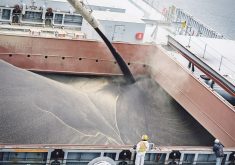Western Producer reporter Ed White is talking to the world’s top market analysts to bring a range of philosophies and insights into the current financial crisis. In this series, the analysts discuss what happened to predictions about the world being in a long-term bull market for commodities and whether the financial crisis changes the long-term outlook for commodities farmers produce. This is the fifth in the series.
David Reimann is a Winnipeg vice-president of Informa Economics Inc., an international agriculture, food, energy commodity market research and analysis company.
Read Also

Russian wheat exports start to pick up the pace
Russia has had a slow start for its 2025-26 wheat export program, but the pace is starting to pick up and that is a bearish factor for prices.
He has worked as a trader, broker, adviser and economic analyst on the Prairies since 1979, during the last bull market in commodities. He has recently been advising farmers on how to market their crops in this environment of volatile prices and an uncertain long-term outlook.
Q: There has been lots of talk during the past few years about a long-term commodity bull market. But since the market peak in July and subsequent fall, many people are challenging the idea. Does the theory still hold water?
A: In reality, it’s correct. There is a long-term expansion in China and India, various Asian countries and Latin America. As we see these economies develop and a middle class grow, people do eat more meat, vegetables and expensive grains. That’ll continue over the next few decades. Where people get confused is over the question of at what pace does that occur. In reality, the growth is slower than the hype of the past few years has called for. A lot of speculative money got into the market and expanded the rally greatly and took it to levels that were unsustainable.
We have to remember, especially in commodities, how fast the market can respond. Wheat is a good example. We had a tight, tight supply last year and by driving prices up like Minneapolis wheat to $25 a bushel and Chicago wheat to $13 a bu. it inspires a lot of wheat-growing around the world. Unlike oil where you have to explore and develop before you have new supply, with wheat you’re one crop away from solving the problem.
Markets don’t just go straight up. They’ll go up, but not like the hype said they would.
Q: A lot of people have gotten excited by the idea that we might be in the situation of “back to the ’70s.” If we are back to the 1970s, what would that mean for farmers?
A: People talk about the ’70s and they forget what the ’70s really looked like. From the ’50s and the ’60s we were used to lows in Chicago wheat of $1.20 to $1.50. Once we hit the ’70s they took off – to almost $7 a bu. But then they backed off and by the mid-’70s we were trading between $2.20 and $2.50. We would get wild gyrations and lots of recovery in the markets, but in general the downtrend continued and we didn’t get a chance to take out those early ’70s highs … until 1996. Until recently we were still sitting at those lows of $2.20 to $2.50 on Chicago wheat.
To me, the new paradigm is that the base price where we used to choke off production and increase demand was $1.20 to $1.50 a bu., and from the ’70s was $2.20 to $2.50. The peaks become pretty tough to predict. Right now we’ve blown through all sorts of historical highs but surely enough we’re dropping back and what we’re trying to establish is the new base price where you choke off production and incite demand. The market is going to establish some new lows where there’s value and I expect it’ll be higher than $2.20 to $2.50.
Once we establish some new lows, I would expect that all of these markets have a chance to do some snap-back recoveries. I think we’re going to see some huge volatility in these markets over a number of years as we establish the new pricing ranges.
For farmers of Western Canada, once we start to see some lows and establish some support levels, you’ll get a better sense of at what price can you hold off. At what point is it worth stopping selling and instead holding grain? We will get some rapid rallies when we have short-covering and weather issues. These will be selling opportunities for grain and oilseed producers. Volatility is opportunity and we’re going to have big opportunities for everyone.
Q: Is it right to think of the 1970s as a time of consistently high prices?
A: No. There were a series of massive peaks in prices, but they were followed by sharp bear markets, much like we’re seeing right now. It’s a very common misperception. People are saying it’s the ’70s all over again. They may be right, but in the ’70s we didn’t see the markets go up and stay there. We saw price spikes, increases in production, followed by prices dropping down again. That’s what people haven’t been prepared for here. Markets don’t just go up and stay there.
Q: How does a farmer market crops in this environment of high volatility? How does a farmer form a marketing plan?
A: What people need to realize is that when the market’s offering a price over the cost of production, you need to make some incremental sales because that allows you to have bin space and cash flow through the low periods, the hard times. Then be patient and wait for these recoveries.
The trick is not getting caught up with either extreme view. Farmers will be tempted again when it rallies to hold back and not sell and you just can’t do that.
Nobody’s really smart enough to pick tops. You need to recognize value and sell along the way. If you take an all or nothing approach in these markets, you’re probably going to get killed. My experience over the years is that you make money between the extremes.
Trying to pick the highs and lows is a fool’s game.
I think if people can get over the anxiety of this extreme volatility and see it as an opportunity, you can be pretty optimistic about where we’re going.
The main message of the “long-term commodity bull market” is, I think, true, but you have to be realistic about how it’s going to unfold.















